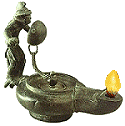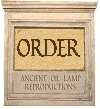
|
Frequently Asked Questions Q: How much is shipping? A: We ship USPS Priority Mail. Cost is based on USPS charges for weight and destination. In most cases shipping will be determined when your lamps are packed. You will be asked only to cover the actual cost of postage.Due to complications, we do not ship out of the US except for Canada. Sorry.
Q: When do I pay? A: You will get a notice when your lamps are ready, and pay then. I do not accept payment before your lamps are ready in case there are unforeseen delays..
Q: What forms of payment do you accept? A: Currently credit cards are only accepted through PAYPAL. You may also use money orders. We arelooking into other online payment options but they are not yet ready to use.Q: Are these reproduction lamps useable? A: Yes. The lamps are low fired ceramics (earthenware). They are fired to the same temperature ranges as original lamps were and, unless requested, they are not glazed (most original lamps were never glazed either). So, like original lamps, they can be used with vegetable oil. Ancient people used olive oil most often. You can use olive oil or less expensive common vegetable cooking oil. Never use any other fuel in these lamps. Also, remember, earthenware is not leak proof. They will absorb oil and if oil is left in them, they will "sweat" it out on the body. Only place a lamp containing oil on easily cleaned and fireproof surfaces, and only use under constant adult supervision. Oil will also "sweat" out during use. It's normal for these. Q. Are the reproduction lamps full size replicas or miniatures? A. These
are full size reproductions.
Many people are
surprised as
they are accustomed to seeing very large oil lamps in the movies.
Generally, the clay lamps used in movies are not historically
accurate. There are some exceptions, and some of my lamps have been
used in productions on the History Channel and The Learning Channel. Some were even used in Jack Black's The Year One.
Most lamps in television and movie productions though are based on
today's concept of how much light is needed with no thought to how much
a typical ancient person expected, or could afford
to spend for lighting oil. Ancient clay lamps came in many sizes and most are very small. The size of each reproduction is listed in the description and all are well within the range of original lamps. If you want a larger lamp that holds a lot of oil, choose a North African style, or if you just want a very big lamp, choose the Agora in the Greek Lamps section.
Q. Can I get my lamps glazed? A. Yes. Very few ancient lamps were ever glazed before the late Islamic period (early Medieval in Europe). Greek lamps which appear glazed are usually only coated with a non-vitrious slip, meaning those aren't true glazes, which are a form of glass. Romans sometimes glazed lamps, green being the most common choice because it was easiest to produce. Your replica lamp can have a clear interior glaze added for a small additional cost (see the order form). Full body glazes can be done for $ 4.00 extra. Be aware, glazing can sometimes delay your lamp request as it requires a second firing.
Q. Do you make custom lamps? A. Yes.
I've made several custom
lamps, mostly for weddings.
The
cost
depends on the style you need. One couple had me make them a lamp with
a
special Hebrew inscription and embossed animal figure, so if you want
something
unique, send me an email. But please keep in mind custom orders can
take
some time to complete, so think early.
Q. Do you have a retail store? A. No. The artifact reproductions are only available online. This is a part time hobby that's run as a service to others who also want copies of ancient lamps.
Q. Where can I get more wicks? A. One wick is included with each lamp. You may make wicks using 100% cotton rope or manufactured lamp wicks. Extra wicks, including linen and hemp, may be available on the order form from time to time, but supplies are unpredictable right now. If it's not on the order form, I don't have them available.
Q. Where is my order- How long does it take? A. Making Roman lamps is (obviously) not a full time occupation. To make a lamp requires preparing the greenware and then firing. Glaze, if requested, takes additional time. Depending on when in the schedule of production and firing your order arrives, it could be from one to five weeks on average. If you need lamps in a hurry, email me and I will try to accommodate you, but it depends on your request. I've had people ask me on a Friday afternoon to have them at their doorstep by Sunday morning. While I enjoy a good laugh, please don't expect miracles.Domestic shipping is usually by USPS Priority mail, so generally it gets to you within a few days of being sent- but sometimes it also takes me a few days to get your order packed after you pay. While I do my best to process your order quickly, in this age of the Internet, it's sometimes hard to remember life is still not instant everywhere- especially in the production of fairly eclectic ancient craft work. Q. How did you come to do this? A. Many
people ask this. It began in the 1980s by wanting to have a working Roman style oil
lamp and being unable to
find one. After some early attempts that worked, but were not
impressive, I set it aside for
several years until as a graduate student I took classes on replicating
artifacts in the lab. (I have a PhD in archaeology and am now a museum curator). After learning to
mold original lamps safely, and finding once I had a mold I could make
multiples, I began to make them for others as well as expand
my selection. By urging of some folks who bought lamps from me, I started offering them more widely in 1994.
Although I took a break from it for awhile, I still made new lamp styles now and then.
Currently the lamps are a mix of direct molds from
ancient
lamps, styles based on originals but not using direct moldings, and now also making initial prototypes using 3D scan technology and printing followed by
creating traditional Roman style molds using those as well. Many others
are
also made with a cast taken using an ancient lamp body, but new decoration added
afterwards.
It usually depends on how fragile the original I have to work with is,
if it's safe to cast, I'll do it directly, if it might damage it, I
model it by hand using the original as a guide. Sometimes creating new
styles gets a bit of an obsession based on seeing a style I like and
not having one similar to it. The lamps are identified in the
description to which they are, direct copies or approximated copies.
Many have
photos of the original lamp it replicates linked to the text. Q. What's "Pilosus Figulus? A. That's Latin for "Hairy Potter." Here's an image of the "Hairy Potter"Q. What's the monkey lamp on the navigation bar? A. That's an original bronze lamp with a chimp dressed as a gladiator. It was found in Pompeii and is in the National Museum in Naples, Italy. I do not have any copies of it. Sorry. |
 |
|
|